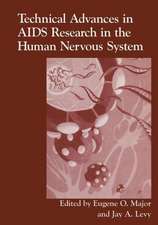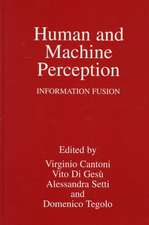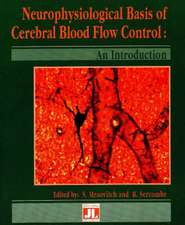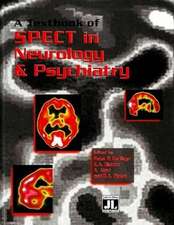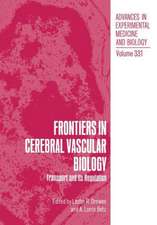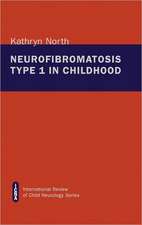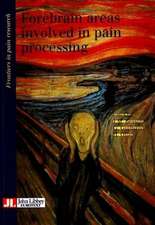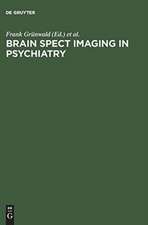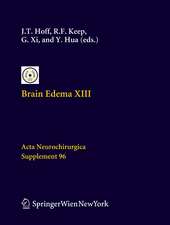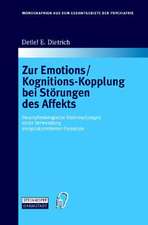Intracranial Pressure VII: Proceedings of the Seventh International Symposium on Intracranial Pressure, Held in Ann Arbor, USA, June 19-23, 1988
Editat de Julian T. Hoff, A. Lorris Betzen Limba Engleză Paperback – 29 dec 2011
Preț: 420.48 lei
Preț vechi: 442.62 lei
-5% Nou
Puncte Express: 631
Preț estimativ în valută:
80.46€ • 83.84$ • 66.62£
80.46€ • 83.84$ • 66.62£
Carte tipărită la comandă
Livrare economică 03-17 aprilie
Preluare comenzi: 021 569.72.76
Specificații
ISBN-13: 9783642739897
ISBN-10: 364273989X
Pagini: 1092
Ilustrații: XXXIII, 1050 p.
Dimensiuni: 170 x 242 x 60 mm
Greutate: 1.7 kg
Ediția:Softcover reprint of the original 1st ed. 1989
Editura: Springer Berlin, Heidelberg
Colecția Springer
Locul publicării:Berlin, Heidelberg, Germany
ISBN-10: 364273989X
Pagini: 1092
Ilustrații: XXXIII, 1050 p.
Dimensiuni: 170 x 242 x 60 mm
Greutate: 1.7 kg
Ediția:Softcover reprint of the original 1st ed. 1989
Editura: Springer Berlin, Heidelberg
Colecția Springer
Locul publicării:Berlin, Heidelberg, Germany
Public țintă
ResearchCuprins
Session I: Monitoring.- Measuring ICP in Patients — Its Value Now and in the Future?.- Physical Characteristics of Various Methods for Measuring ICP.- An Approach to Noninvasive Analysis of Intracranial Pressure (ICP) Using an Ultrasonic Probe.- Clinical Evaluation of the Catheter Tipped Camino Transducer Inserted via a Subdural Screw.- Clinical and Laboratory Evaluation of the Camino Intracranial Pressure Monitoring System.- Clinical Experience with a Fiber Optic Brain Parenchymal Pressure Monitor.- Test of a Non-invasive PVI Measure with a Fiber-optic Pressure Monitoring Device in Head Injured Patients.- Differential Intracranial Pressure Recordings in Patients with Dual Ipsilateral Monitors.- A New Fiberoptic Monitoring Device: Development of the Ventricular Bolt.- Development of a Fully Implantable Epidural Pressure (EDP) Sensor.- Evaluation of a Fibre-optic System for Monitoring Ventricular Pressure.- Clinical Evaluation of a Fiberoptic Device for Measuring PVI.- Microprocessor-driven ICP Fiber Optic Monitor.- Microprocessor-driven ICP Monitor: Instrumentation.- Comparison of Intracranial Pressure Transducers.- Intraparenchymal Brain Pressure — Clinical Evaluation.- Lumbar Pressure Monitoring with a New Fiberoptic Catheter.- Evaluation of Continuous Lumbar Subarachnoid Pressure Monitoring.- Intracranial Pressure Monitoring After Elective Surgery: A Study of 514 Consecutive Patients.- Intracranial Compliance Monitoring with Computerized ICP Waveform Analysis in 55 Comatose Patients.- Software for Neurosurgery Intensive Care.- The Best Dichotomous Parameters for Predicting Mortality and a Good Outcome Following 48 Hours of ICP Monitoring.- Non-invasive Monitoring of ICP in Infants.- The Human Factor in the Accuracy of Intracranial Pressure (ICP) Monitoring Using Extradurally Placed Microtransducers.- Rate of Infection and Cost Containment in Intracranial Pressure Recording.- Continuous Monitoring of Middle Cerebral Arterial Blood Velocity and Cerebral Perfusion Pressure.- Analysis of Frequency Spectrum of the Intracranial Pulse Wave in Cerebral Vasospasm.- Intracranial Volume and Pressure Load Tolerance Evaluated by Continuous Measurement of Doppler Flow Velocity in Intracranial Vessels in Cats.- Simultaneous Monitoring of ICP and Transcranial Doppler Sonogram on the Middle Cerebral Artery.- Effect of Jugular Bulb Catheterization on Intracranial Pressure.- Jugular Bulb Catheterization in Children.- Transcardiac Method of Jugular Bulb Catheterization.- Dynamic Pressure Volume Index via ICP Waveform Analysis.- Single Pulse Pressure Wave Analysis by Fast Fourier Transformation.- A Minicomputer System for Analysis and Display of ICP Related Data.- Modified Auditory Brainstem Responses (MABR) in Patients with Intracranial Lesions.- Detection of the Site of V-P Shunt Malfunction Using a Telemetric IVP Sensor.- Relatiomship of Intracranial Pressure Changes to CT Changes in Children.- Noninvasive Measurement of Intracranial Pressure (ICP) as a Screening Method for Evaluation of Hydrocephalus in Newborn and Infants.- Correlations Between CT Features and ICP in Patients with Intracranial Lesions.- EEG Spectrum Changes After the Bolus Injection of Thiopental.- Session II: Biophysics Session.- Can Waveform Analysis of ICP Separate Vascular from Non-Vascular Causes on Intracranial Hypertension?.- The Origin of CSF Pulse Waves.- Significance of Cortical Venous Pulse Pressure and Superior Sagittal Sinus Pulse Pressure on ICP-Pulse Pressure.- Mathematical Modelling of the Contribution of Arterial Volumetric Pulsation to the Intracranial Pulse Wave.- Single Pulse Spectral Analysis of Intracranial Pressures.- Fourier Analysis of Intracranial Pressures During Experimental Intracranial Hypertension.- Analysis of the Power Spectrum of the Pulse Pressure Wave During Induced Intracranial Hypertension in Humans.- CSF Pulse Waves in a Model of Progressive Hydrocephalus: An Effect Not a Cause of Ventricular Enlargement.- Normal Pressure Hydrocephalus: A Retrospective Study on Clinico-Radiological Data, CSF Dynamics and CSF Pulse Waveform Morphology.- Application of Advanced Forms of Intracranial Pressure Analysis in Craniosynostosis.- CSF Pulse Waveform Morphology as an Indicator of Intracranial System Impedance: An Experimental Study.- Transmission Characteristics of Pulse Waves in the Intracranial Cavity of Dogs During Normal Intracranial Condition, Intracranial Hypertension, Hypercapnia, and Hydrocephalus.- Cerebral Pulse Amplitude in a Canine Model of “Slit” Ventricle Syndrome.- Intracranial and Venous Pressures, Part I: Intracranial Pulse Wave Changes During Hemodynamic Maneuvers in Humans.- Intracranial and Venous Pressures, Part II: Extracranial Source of B-Waves.- B-Waves in Healthy Persons.- Correlation Between B-Waves and Intracranial Pressure — Volume Relationships.- Respiratory and Cardiovascular Oscillations During B-Waves.- The Role of Vasomotor Center and Adrenergic Pathway in B-Waves.- Intracranial Pressure Pulse Wave Form and Its dp/dt Analysis of Plateau Waves.- The Roles of the Mutual Interaction Between the Locus Coeruleus Complex and the Chorioceptive Pontine Area in the Plateau Wave.- Role of the Medulla Oblongata in Plateau Wave Development in Dogs.- Electroencephalographic Changes During Plateau Waves–Plateau Waves Induced by Electrical Stimulation of the Brain Stem.- Changes of Evoked Potentials During Pressure Waves.- Comparative Study with Experimental and Clinical Plateau Waves Relating to Sleep.- Failure in Aborting Plateau Waves by a Temporary Increase in Cerebral Perfusion Pressure.- The Plateau Wave is Not Solely an Intracranial Phenomenon.- Slow Oscillation of Compliance and Pressure Rate in the Naturally Closed Cranio-Spinal System.- Remarks on Amplitude-Pressure Characteristic Phenomenon.- Non-Provocative Assessment of Intracranial Volume — Pressure Relationships.- The Viscoelasticity of Normal and Hydrocephalic Brain Tissue.- Intracranial Elastance: Spline Interpolation vs Exponential Function.- Brain Tissue Elasticity and CSF Elastance.- High Frequency Ventilation vs Conventional Mechanical Ventilation: Their Influence on Cerebral Elastance.- Brain Elasticity Changes in a Canine Model of Pseudotumor Cerebri.- Cerebral Elasticity and Ventricular Size, Part I: Normalization of Ventricles Following Shunting.- Cerebral Elasticity and Ventricular Size, Part II: Age-Related Development of Extracerebral Fluid Collections.- Intracranial Pressure Changes from a Temporal Lobe Mass in Cats.- Increase in ICP Produced by Electrical Stimulation of the Brain Stem Reticular Formation in Cats with Spinalization and Vagotomy.- Computer Simulation of Intracranial Pressure Using Electrical R-C Circuit.- Session III: CSF Dynamics and Hydrocephalus.- Exchange vs Cotransport of Na and Cl Across the Barriers Interfacing Cerebrospinal Fluid and Brain with Blood.- Omeprazole, an Inhibitor of H+ -K+ -ATPase, Markedly Reduces CSF Formation in the Rabbit.- Glucocorticoid Effects on Choroid Plexus Function.- Sex Steroids and Transport Functions in the Rabbit Choroid Plexus.- Axonal Coexistence of Certain Transmitter Peptides in the Choroid Plexus.- Effect of Sympathetic Denervation on the Cerebral Fluid Formation Rate in Increased Intracranial Pressure.- CSF Production in Patients with Increased Intracranial Pressure.- Changes in Intracranial CSF Volume After LP.- Changes in Intracranial CSF Volume During Hypercapnia and Hypocapnia.- Intracranial CSF Volume Distribution in Normal Pressure Hydrocephalus.- Benign Intracranial Hypertension: Brain Swelling and Cranial CSF Volume.- CSF Distribution in Acute and Chronic Obstructive Hydrocephalus and the Response to Shunting.- Reproducibility and Reliability of Measurement of Resistance to CSF Outflow by Subarachnoid Perfusion.- Measurement of Resistance to CSF Outflow-Clinical Experiences in 333 Patients.- Further Analysis of the Bolus Injection Technique for Resistance Measurements.- Comparison of Resistance to Outflow (Rout) Measured by Ventricular and Lumbar Perfusion.- CSF Dynamics and Ventricular Size in Experimental Sagittal Sinus Occlusion Models.- The Importance of Outflow Resistance of the Shunt System for Elimination of B-Waves.- Benign Intracranial Hypertension: CSF Dynamics and CSF Pulse Wave Morphology.- CSF Dynamies in Patients with Suspected Normal Pressure Hydrocephalus.- The Significance of Outflow Resistance Measurements in the Prediction of Outcome After CSF-Shunting in Patients with Normal Pressure Hydrocephalus.- Does Compliance Predict Ventricular Reduction After Shunting for Normal Pressure Hydrocephalus.- Attempts to Predict the Probability of Clinical Improvement Following Shunting of Patients with Presumed Normal Pressure Hydrocephalus.- Different Time Course of Clinical Symptoms and CSF Dynamics in Patients with Pseudotumor Cerebri.- Intracranial Pressure on Pre- and Post-Shunt Surgery in Patients with Normal Pressure Hydrocephalus (NPH).- CSF Hydrodynamics and CSF Flow Through a Shunt in Hydrocephalus.- Normal Pressure Hydrocephalus in Children — The State of Hypercompensation.- CSF Pulsatile Flow on MRI and Its Relation to Intracranial Pressure.- Changes of CSF Migration, Energy Metabolism and High Molecular Protein of the Neuron in Hydrostatic Intracranial Hypertension.- Increased Brain Water Self Diffusion Measured by Magnetic Resonance Scanning in Patients with Pseudotumor Cerebri.- Neuropsychological Testing in Normal Pressure Hydrocephalus.- 123I-IMP-SPECT and Lumbar Subarachnoid Pressure in Adult Hydrocephalus.- Concentrations of Neurotransmitters in Ventricular and Lumbar Cerebrospinal Fluid in Patients with Normal Pressure Hydrocephalus.- CSF Oxygen Tension and ICP.- Possible Physiological Role of the Cushing Response During Parturition.- Electrocardiographic Changes are Associated with Elevated Blood Pressure Rather Than a Direct Effect of Raised Intracranial Pressure.- Session IV: Control of ICP.- Effect of Mannitol on Experimental Infusion Edema.- Immediate and Long-term Effects of Mannitol and Glycerol: A Comparative Experimental Study.- Effects of Mannitol on Spontaneous Tone of Intracerebral Arterioles.- Experimental Cerebral Edema, Isotonic Intravenous Infusions, Mannitol, Serum Osmolality, Electrolytes, Brain Water, Intracranial Pressure, and Cerebral Blood Flow.- Effects of Mannitol-Induced Hemodynamic Changes on Intracranial Pressure Responses in Dogs.- The Effect of Rapid Mannitol Infusion on Cerebral Blood Volume.- A Study of the Concentration of Mannitol for the Treatment of Raised ICP.- Paired Comparison of Hypnotic and Osmotic Therapy in the Reduction of Intracranial Hypertension After Severe Head Injury.- The Level of ICP Modifies the CSF Pressure Response to Changes in MAP and CVP After Mannitol.- Lidocaine Can Reduce Intracranial Pressure Associated with Intracranial Space-Occupying Lesions.- ICP Reduction by Lidocaine: Dose Response Curve and Effect on CBF and EEG.- The Effect of Superimposed High-Frequency Auxiliary Ventilation on Intracranial Pressure.- Does Increased FiO2 Alter NADH Redox State and Protect Brain Cells from Intracranial Pressure Change in Rabbits?.- Treatment of Increased Intracranial Pressure Using Oncodiuretic Therapy: Combined Albumin and Furosemide.- Induced Arterial Hypertension in the Treatment of High ICP.- Intracranial Pressure in Preterm Infants: Effects of Nursing and Parental Care.- Intracranial Pressure Controlled Therapy of Brain Edema in Cerebrovascular Disease.- Cerebro-Spinal Fluid Pressure Changes and Rate of Recovery After Propofol for Elective Craniotomy.- Influence of Single Bolus of Propofol on Cerebrospinal Fluid Pressure and Cerebral Blood Flow Velocity.- Impact of Sufentanil on ICP in Patients with Brain Tumors.- Effects of Antihypertensive Drugs on Intracranial Hypertension.- ICP- and IOP-Effects of Deliberate Hypotension Using Urapidil.- No Effect on ICP of ACE-Inhibition During Induced Hypotension.- Propofol and Intracranial Pressure.- Session V: Trauma, Hemorrhage and Inflammation.- The Traumatic Coma Data Bank: Monitoring of ICP.- Head Injury: Outcome in 4 Regional Head Injury Centers — Preliminary Report.- CT Scan Findings in 683 Patients with Severe (GCS ? 8) Closed Head Injury: A Report from the NIH Traumatic Coma Data Bank.- Brain Swelling in Fatal Head Injuries.- The Significance of Intracerebral Hematoma Location on the Risk of Tentorial Herniation and Clinical Outcome.- Outcome After Diffuse Head Injuries and ICP Elevations.- ICP in the Elderly Head Injury Population.- Isolated Stimulation of Glycolysis Following Traumatic Brain Injury.- N-Methyl-D-Aspartate (NMDA) Receptor Antagonists in the Treatment of Experimental Brain Injury: 31P Magnetic Resonance Spectroscopy and Behavioral Studies.- Ion Fluxes and Cell Swelling in Experimental Traumatic Brain Injury: The Role of Excitatory Amino Acids.- Neuron-Specific Enolase and S-100 Protein in CSF: Objective Markers of Structural Brain Damage.- Time Course of Brain Tissue Pressure in Temporal Fluid Percussion Injury.- Improved Outcome as a Result of Recognition of Absent and Compressed Cisterns on Initial CT Scans.- An Effacement Score for Basal Cisterns to Predict ICP Level and Outcome After Severe Closed Head Injury.- The Relation Between Glasgow Coma Scale (GCS) and a Regional Lesion Index Based on CT-Scans in Patients with Extradural Hematomas.- Volume/Pressure Rebound with Mannitol in Head Injured Patients with Raised ICP.- Prospective, Randomized Trial of THAM Therapy in Severe Brain Injury: Preliminary Results.- THAM (Tromethamine, “Tris-Buffer”): Effective Therapy of Traumatie Brain Swelling?.- rCBF Following an Experimental Missile Wound to the Brain.- Transtentorial Brain Herniation in the Monkey: Predictive Value of Brain-Stem Auditory and Somatosensory Evoked Responses.- Relationship Between Clinical Course, CT Scan and ICP in Post-Traumatic Diffuse Lesions.- Effeet of Prophylactic Hyperventilation on Outcomc in Patients with Severe Head Injury.- The PA/ICP-Relation in Head-injured Patients: Is There Only One Relationship?.- Tomographic Mapping of CBF, CBV and Blood Brain Barrier Changes in Humans After Focal Head Injury, Using SPECT-Mechanisms for Late Deterioration.- Optimal Cerebral Perfusion Pressure in Head Injury.- Effect of Stable Xenon Inhalation on ICP in Head Injury.- Experimental Epidural Bleeding in Swine: ICP Course, Mass Displacement, Changes in Brain Tissue Water and the Effects of INFIT.- Cerebral Coneussion Suppresses Hippocampal Long-term Potentiation (LTP) in Rats.- Histological Changes of the Brain by Experimental Extradural Compression.- Effeet of Hemorrhagic Hypotension on CBF and ICP After Brain Missile Wounding in Anesthetized Paralyzed Cats.- The Relation Between Mass Effeet of Extradural Hematomas and Glasgow Coma Seale (GCS).- Predicting Neuropsychological Outcome by Physiological Parameters of Severe Head Injured Patients.- Neuronal Dysfunction and Intracranial Pressure: Multimodal Monitoring of Severely Brain-Damaged Patients.- Methodology of Spectral Analysis of the Intracranial Pressure Waveform in a Head Injury Intensive Care Unit.- Effects of Intracranial Hypertension on Evolution of Post-Traumatic Acute Subdural Hematoma.- Experimental Arterial Subdural Bleeding.- Hyperacute Arrest of Intracranial Bleeding with Intracranial Fluid Infusion Tamponade Treatment (INFIT).- Blood Volume Responsivity to ICP Change in Head Injured Patients.- Relation Between CBF, ICP and PVI in Severely Head Injured Children.- Biochemical and Biophysical Parameters Under Thiopental Infusion in Severe Head Injured Patients.- ICP-Course After Weaning from Artificial Ventilation in Patients with Severe Brain Trauma.- Evaluation of Medical Management for Severe Head Injury.- Intracranial Pressure Changes in Response to Deep Brain Stimulation in Traumatic Prolonged Coma Patients.- The Use of Narcotics and Hyperventilation for the Treatment of Posttraumatic Brain Swelling: Theoretical Basis and Clinical Experience.- Relationship Between Attenuation Changes on CT and Posttraumatic CSF-CKBB-Activity in Severely Head-Injured Patients.- ICP and Biomechanical Responses After Closed Impact Injury to the Spinal Cord.- Intracranial Pressure in Experimental Subarachnoid Haemorrhage.- Cortical Tissue Pressure in Injured Brain After Subarachnoid Hemorrhage.- Experimental Hypertensive Putaminal Hemorrhage: Part 1. Physiological Study.- Experimental Hypertensive Putaminal Hemorrhage: Part 2. Pathological Study.- Estimation of Intracranial Pressure in Acute Subarachnoid Hemorrhage Based on CT.- Intracranial Pressure (ICP) and Cerebral Blood Flow Velocity (BFV) in Patients with Subarachnoid Hemorrhage Under Treatment with Nimodipine.- ICP in the Diagnosis of Acute Hydrocephalus After Aneurysmal Subarachnoid Hemorrhage.- Resistance to Cerebrospinal Fluid Outflow Following Subarachnoid Haemorrhage.- External Ventricular Drainage in the Management of Hypertensive Intracerebral Hemorrhage with Rupture Into the Ventricles.- Effects of Glycerol Infusion on Cerebral Blood Flow in Hypertensive Intracerebral Hematoma with Ventricular Hemorrhage.- Pressure Waves and Brain Stem Microcirculatory Disturbance Following Experimental Subarachnoid Hemorrhage.- Raised Intracranial Pressure (RICP) and Cerebral Blood Flow (CBF): A Comparison of Xenon Clearance and Single Photon Emission Tomography (SPET).- Cerebral Energy Metabolism During Post-Traumatic Hypoventilation.- Effects on Intracranial Pressure In a Clinically-Derived Fluid Resuscitation Protocol Following Hemorrhagic Shock with an Accompanying Intracranial Mass.- Continuous Monitoring of ICP, CPP and BAER. Significance of Concomitant Changes.- The Effect of Posttraumatic Hypoxia on ICP in Rats.- Neuro-Intensive Care for Cerebral Herniation in Childhood Meningitis.- ICP, CSF Outflow Resistance and Brain Edema in Experimental Pneumococcal Meningitis.- Brain Edema, ICP and CSF Outflow Resistance in Experimental Pneumococcal Meningitis: Effect of Mannitol and Antiinflammatory Drugs.- Changes of Intracranial Pressure in a Rat Meningitis Model.- Session VI: Free Radicals.- Oxygen Radicals in Experimental Brain Injury.- Oxygen Free Radicals in the Genesis of Traumatic Brain Edema.- Reduction of Intracranial Hypertension with Free Radical Scavengers.- Allopurinol and Dimethylthiourea Limit Infarct Size in Partial Ischemia.- The Effect of Superoxide Dismutase on Rabbit Brain Reperfusion Injury.- The Role of Catecholamine-Induced Lipid Peroxidation and Histamine in Ischemic Brain Edema.- Session VII: Cerebral Perfusion and Metabolism.- ICP and PVI with Blood Pressure Alterations and Relation with CBF Autoregulation.- Cerebral Perfusion Pressure, Autoregulation and the PVI Reflection Point: Pathological ICP.- Pressure-volume Index as a Function of Cerebral Perfusion Pressure, Autoregulation and Anesthesia.- A Cerebral Perfusion Pressure Greater than 80 mm Hg is More Beneficial.- Vasodilatory Cascade: ICP Response to CPP Level and Reduction Rate.- Experimental Study of the Correlation Between Evoked Potentials (SEP and AEP) and the Perfusion Pressure.- Correct Measurement of Cerebral Perfusion Pressure (CPP).- Critical Thresholds of Rebound of ICP After Cerebral Compression.- Critical Thresholds of ICP and Cerebral Perfusion Pressure (CPP) for Cerebral Blood Flow and Brain Functions — Noninvasive Study.- Flow Threshold in Increased Intracranial Pressure.- Influences of Intracranial Pressure on Regional Cerebral Blood Flow.- Circulatory Disturbances of Cerebral Blood Vessels During Increased Intracranial Pressure.- Two Dimensional Analysis of Microcirculation, Vascular Permeability, Energy Metabolism, Ion Exchanges in Intracranial Hypertension.- Intracranial Pressure (ICP) Correlation with Cytochrome a, a3 and Hemoglobin Redox State Measured by Noninvasive Near Infrared Spectrophotometry.- Cerebral Hemodynamics in Benign Intracranial Hypertension Studied with PET.- CBF-Studies in Patients with NPH: The Frontal Flow Pattern.- Perioperative Intracranial Hypertension in Patients with Supratentorial Tumors: Role of CBF Changes vs Importance of Mass Effect.- Local Brain Pressure, Microcirculation and pH During Neurosurgical Operations.- Effects of Barbiturate Anesthesia and Hyperventilation on CBF in Patients with Brain Tumors.- Barbiturates, Cerebral Blood Flow and Intracranial Hypertension.- Cerebral Vasoconstriction is Not Maintained with Prolonged Hyperventilation.- The Effect of High Frequency Ventilation on Cerebral Blood Flow and Cerebrovascular Autoregulation in Rabbits.- Effects of Glycerol on Cerebral Blood Flow and Oxygen Metabolism.- Effects of Glycerol on Brain Function in Normal Volunteers — Study on Regional Cerebral Blood Flow, Average Topographie EEG and Significance Probability Mapping.- Intracranial Pressures in Conscious Sheep During 72 Hours of Hypoxia.- Correlation Between Epidural Pressure and Cerebral Metabolism in Rat with Main Cerebral Artery Occlusion with Silicone Embolus.- Ischemia-Reperfusion Injury in the Rabbit Brain.- Changes in Vascular Permeability to FITC-Dextran Following Temporary Occlusion of Middle Cerebral Artery in CAT.- Oxidative Metabolism of 6-(14C)-Glucose During Normoxia, Hypoxia, and Recovery.- The Effect of Cerebral Edema on Reperfusion Blood Flow Deficit in Ischemic Animals.- Critical Time After Reversible Brain Ischemia for Pentobarbital Administration in the Gerbil.- Recovery Rates of Evoked Potentials, Intracellular pH and Bicarbonate Ion After ICP-Induced Ischemia.- An Experimental Model of “Brain Tamponade”. Preliminary Observations on ICP Dynamies, Carotid Blood Flow Velocitometry and EEG Activity.- Cerebral Microvascular Flow Measured by Laser Doppler.- Vasomotor Response and Blood-Brain Barrier Function of Rat Brain Studied in a Closed Cranial Window Preparation.- Session VIII: Edema.- Effect of the Pressure Gradient on Hydrostatic Brain Edema.- Preservation of Tissue Sampies for Measurement of Cerebral Edema.- A CT Study on Formation, Propagation and Resolution of Brain Edema Fluid in Human Peritumoral Edema.- Statistical Analysis of Changes in Topographie EEG on Brain Tumor Cases with Peritumoral Edema.- The Blood: Brain Osmotic Gradient in Ischemic Brain Injury.- Brain Biomechanics and Focal Ischemic Injury.- The Role of Oxidative Reactions in Decompression Ischemic Edema.- Fatal Brain Edema After Total Cerebral Ischemia in Man.- Effect of Mannitol on Ischemic Brain Edema.- Colloid Volume Expansion and Brain Edema.- The Effect of IV Fluids on Cerebral Edema After Experimental Blunt Head Trauma.- The Effects of Nonsteroid Anti-Inflammatory Agent BW755C on Traumatic and Peritumoral Brain Edema.- Effects of Recombinant Lipocortin on Brain Edema of Cytotoxic and Vasogenic Type.- Anti-Edema Effect of Protease Inhibitors.- Thromboxane Inhibition Does Not Prevent Brain Edema After Head Trauma.- Is There No Way for the Treatment of Ischemic Brain Edema?.- Acute Brain Swelling and Edema by Stimulation of the Medullary Reticular Formation in Cold Injured Brain.- Time-Dependent Effects of Central Vasopressin Administration on Cold-Induced Vasogenic Edema in Cats.- The Effect of Hyperglycemia on the Progression of Vasogenic Edema Following Cold Injury.- Effects of Arterial Hypertension and Jugular Vein Ligation on Edema Formation in Acute Brain Swelling Induced by Multiple Cold Lesions.- Brain Edema and Calcium Content Following Closed Head Injury.- Elevated Brain Water During Urease-Induced Hyperammonemia in Dogs.- Study on FGP Cells in Cerebral Edema.- Intracranial Serum Proteins Under Several Blood-Brain Barrier (BBB) Conditions. Electrophoretographic Analysis.- Cerebra I Endothelial Regeneration Following Brain Injury.- Neurological Complications of Eclampsia.

